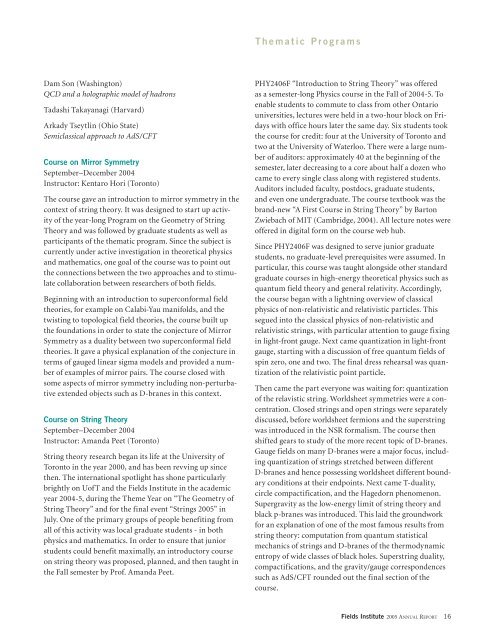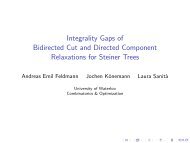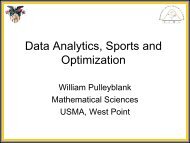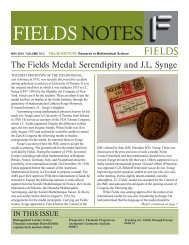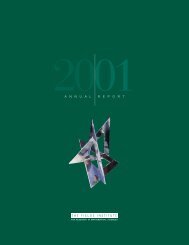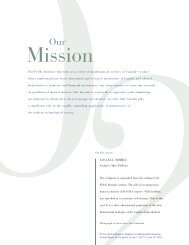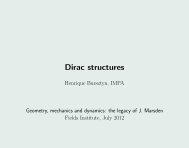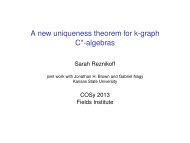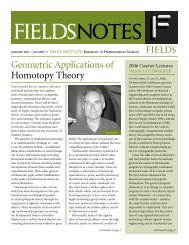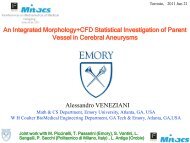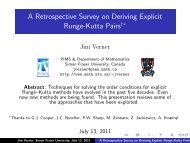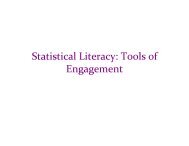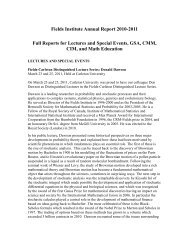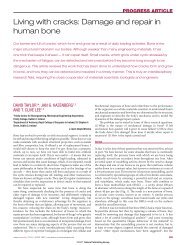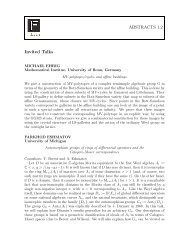Annual Report 2005 - Fields Institute - University of Toronto
Annual Report 2005 - Fields Institute - University of Toronto
Annual Report 2005 - Fields Institute - University of Toronto
You also want an ePaper? Increase the reach of your titles
YUMPU automatically turns print PDFs into web optimized ePapers that Google loves.
Dam Son (Washington)<br />
QCD and a holographic model <strong>of</strong> hadrons<br />
Tadashi Takayanagi (Harvard)<br />
Arkady Tseytlin (Ohio State)<br />
Semiclassical approach to AdS/CFT<br />
Course on Mirror Symmetry<br />
September–December 2004<br />
Instructor: Kentaro Hori (<strong>Toronto</strong>)<br />
The course gave an introduction to mirror symmetry in the<br />
context <strong>of</strong> string theory. It was designed to start up activity<br />
<strong>of</strong> the year-long Program on the Geometry <strong>of</strong> String<br />
Theory and was followed by graduate students as well as<br />
participants <strong>of</strong> the thematic program. Since the subject is<br />
currently under active investigation in theoretical physics<br />
and mathematics, one goal <strong>of</strong> the course was to point out<br />
the connections between the two approaches and to stimulate<br />
collaboration between researchers <strong>of</strong> both fields.<br />
Beginning with an introduction to superconformal field<br />
theories, for example on Calabi-Yau manifolds, and the<br />
twisting to topological field theories, the course built up<br />
the foundations in order to state the conjecture <strong>of</strong> Mirror<br />
Symmetry as a duality between two superconformal field<br />
theories. It gave a physical explanation <strong>of</strong> the conjecture in<br />
terms <strong>of</strong> gauged linear sigma models and provided a number<br />
<strong>of</strong> examples <strong>of</strong> mirror pairs. The course closed with<br />
some aspects <strong>of</strong> mirror symmetry including non-perturbative<br />
extended objects such as D-branes in this context.<br />
Course on String Theory<br />
September–December 2004<br />
Instructor: Amanda Peet (<strong>Toronto</strong>)<br />
String theory research began its life at the <strong>University</strong> <strong>of</strong><br />
<strong>Toronto</strong> in the year 2000, and has been revving up since<br />
then. The international spotlight has shone particularly<br />
brightly on U<strong>of</strong>T and the <strong>Fields</strong> <strong>Institute</strong> in the academic<br />
year 2004-5, during the Theme Year on “The Geometry <strong>of</strong><br />
String Theory” and for the final event “Strings <strong>2005</strong>” in<br />
July. One <strong>of</strong> the primary groups <strong>of</strong> people benefiting from<br />
all <strong>of</strong> this activity was local graduate students - in both<br />
physics and mathematics. In order to ensure that junior<br />
students could benefit maximally, an introductory course<br />
on string theory was proposed, planned, and then taught in<br />
the Fall semester by Pr<strong>of</strong>. Amanda Peet.<br />
T h e m a t i c P r o g r a m s<br />
PHY2406F “Introduction to String Theory” was <strong>of</strong>fered<br />
as a semester-long Physics course in the Fall <strong>of</strong> 2004-5. To<br />
enable students to commute to class from other Ontario<br />
universities, lectures were held in a two-hour block on Fridays<br />
with <strong>of</strong>fice hours later the same day. Six students took<br />
the course for credit: four at the <strong>University</strong> <strong>of</strong> <strong>Toronto</strong> and<br />
two at the <strong>University</strong> <strong>of</strong> Waterloo. There were a large number<br />
<strong>of</strong> auditors: approximately 40 at the beginning <strong>of</strong> the<br />
semester, later decreasing to a core about half a dozen who<br />
came to every single class along with registered students.<br />
Auditors included faculty, postdocs, graduate students,<br />
and even one undergraduate. The course textbook was the<br />
brand-new “A First Course in String Theory” by Barton<br />
Zwiebach <strong>of</strong> MIT (Cambridge, 2004). All lecture notes were<br />
<strong>of</strong>fered in digital form on the course web hub.<br />
Since PHY2406F was designed to serve junior graduate<br />
students, no graduate-level prerequisites were assumed. In<br />
particular, this course was taught alongside other standard<br />
graduate courses in high-energy theoretical physics such as<br />
quantum field theory and general relativity. Accordingly,<br />
the course began with a lightning overview <strong>of</strong> classical<br />
physics <strong>of</strong> non-relativistic and relativistic particles. This<br />
segued into the classical physics <strong>of</strong> non-relativistic and<br />
relativistic strings, with particular attention to gauge fixing<br />
in light-front gauge. Next came quantization in light-front<br />
gauge, starting with a discussion <strong>of</strong> free quantum fields <strong>of</strong><br />
spin zero, one and two. The final dress rehearsal was quantization<br />
<strong>of</strong> the relativistic point particle.<br />
Then came the part everyone was waiting for: quantization<br />
<strong>of</strong> the relavistic string. Worldsheet symmetries were a concentration.<br />
Closed strings and open strings were separately<br />
discussed, before worldsheet fermions and the superstring<br />
was introduced in the NSR formalism. The course then<br />
shifted gears to study <strong>of</strong> the more recent topic <strong>of</strong> D-branes.<br />
Gauge fields on many D-branes were a major focus, including<br />
quantization <strong>of</strong> strings stretched between different<br />
D-branes and hence possessing worldsheet different boundary<br />
conditions at their endpoints. Next came T-duality,<br />
circle compactification, and the Hagedorn phenomenon.<br />
Supergravity as the low-energy limit <strong>of</strong> string theory and<br />
black p-branes was introduced. This laid the groundwork<br />
for an explanation <strong>of</strong> one <strong>of</strong> the most famous results from<br />
string theory: computation from quantum statistical<br />
mechanics <strong>of</strong> strings and D-branes <strong>of</strong> the thermodynamic<br />
entropy <strong>of</strong> wide classes <strong>of</strong> black holes. Superstring duality,<br />
compactifications, and the gravity/gauge correspondences<br />
such as AdS/CFT rounded out the final section <strong>of</strong> the<br />
course.<br />
<strong>Fields</strong> <strong>Institute</strong> <strong>2005</strong> ANNUAL REPORT 16


